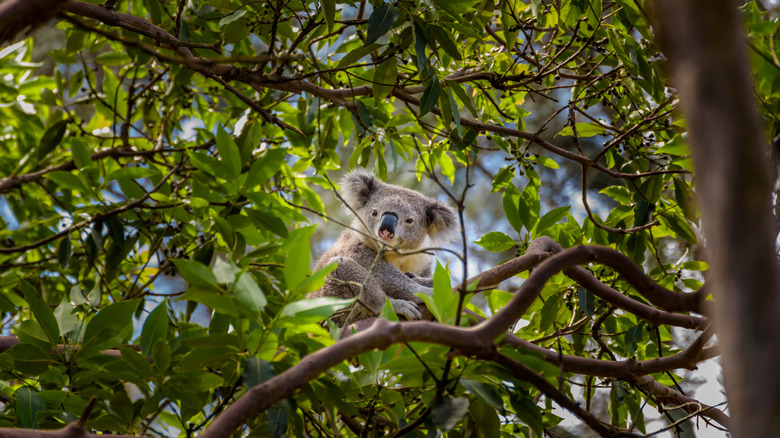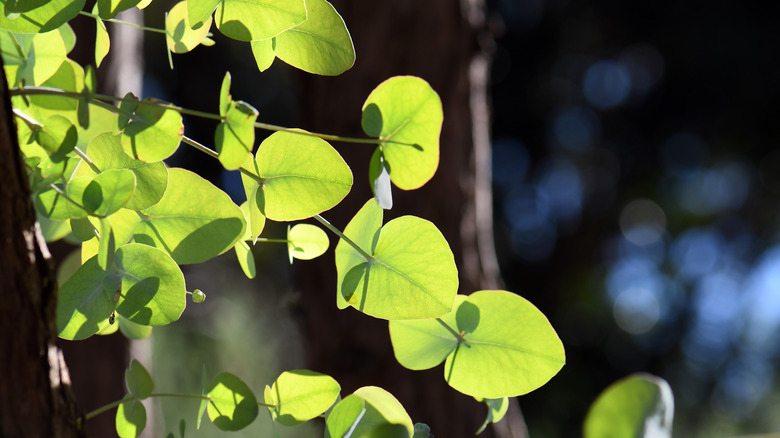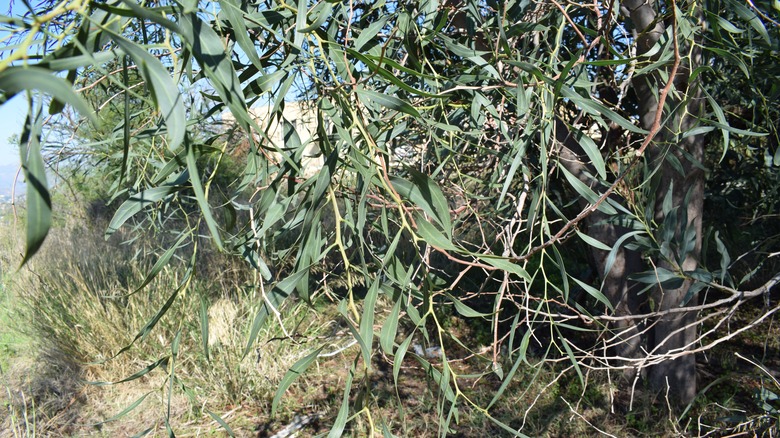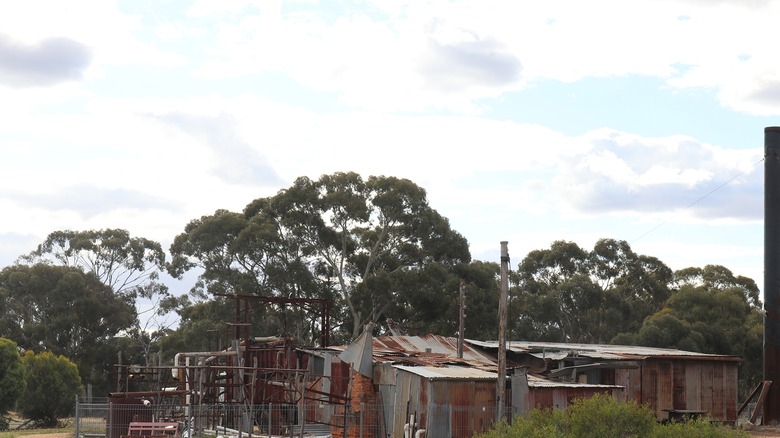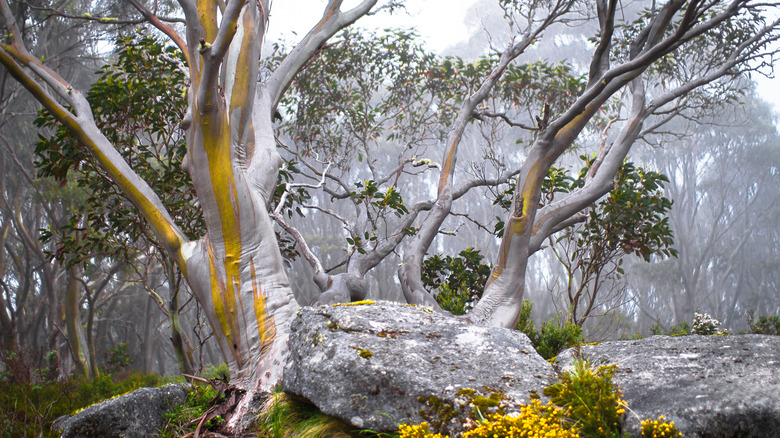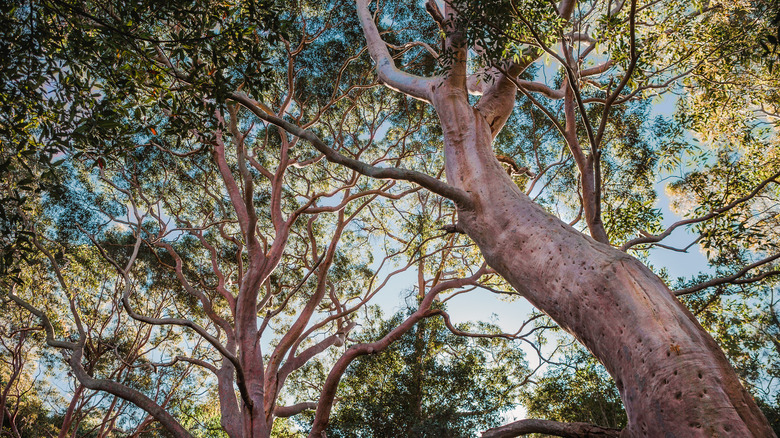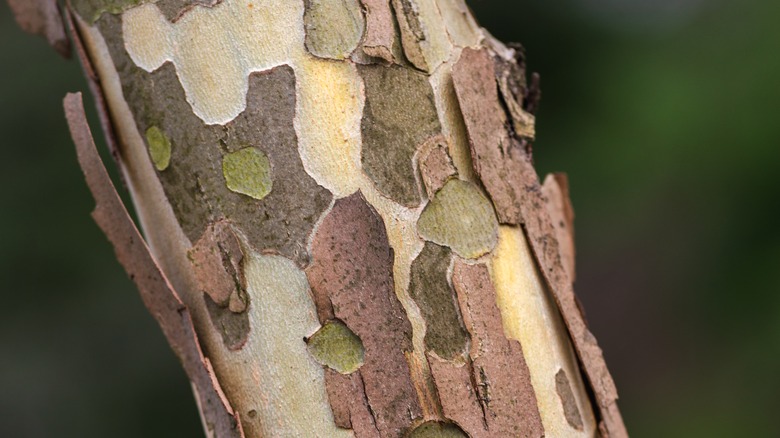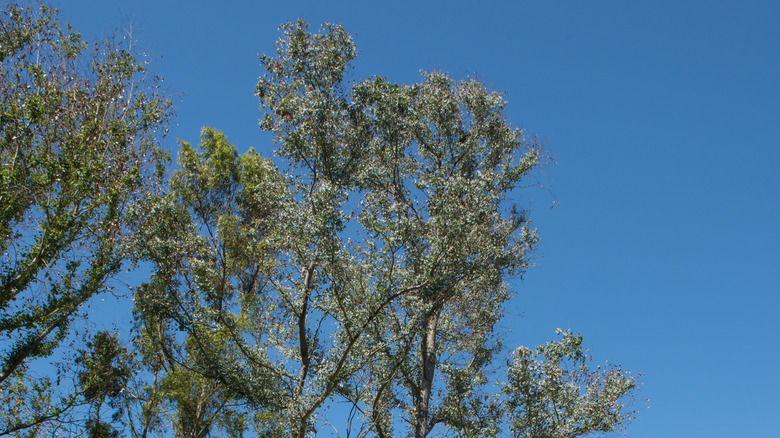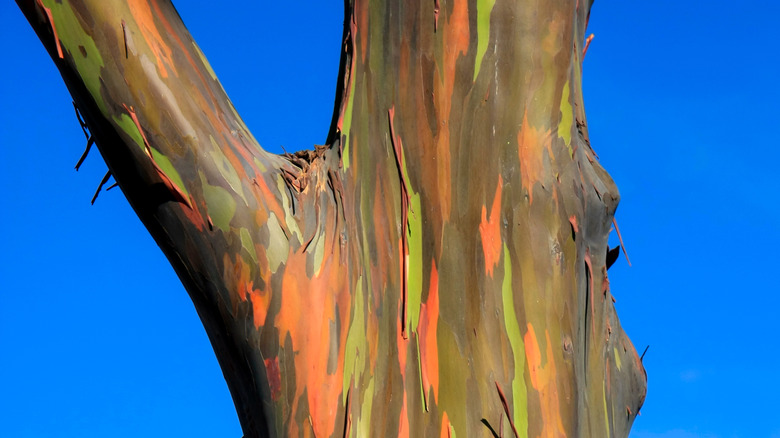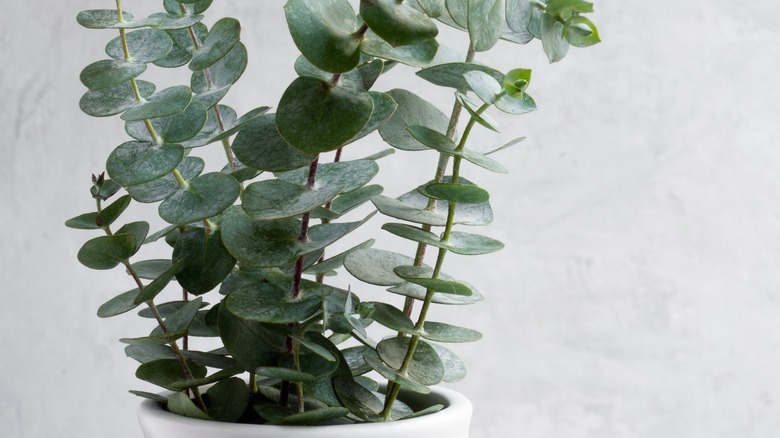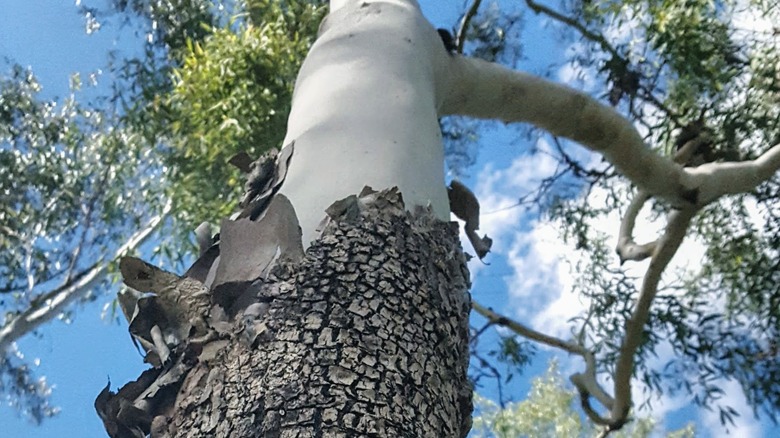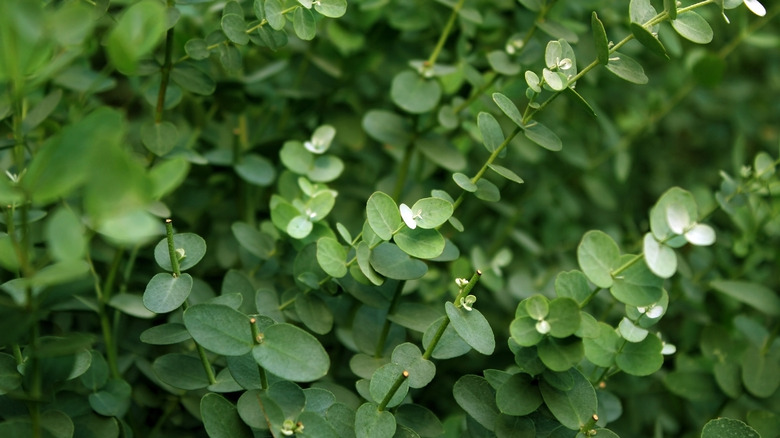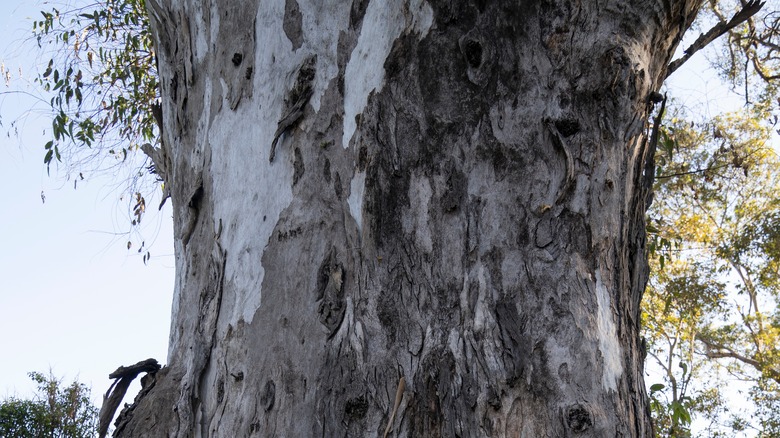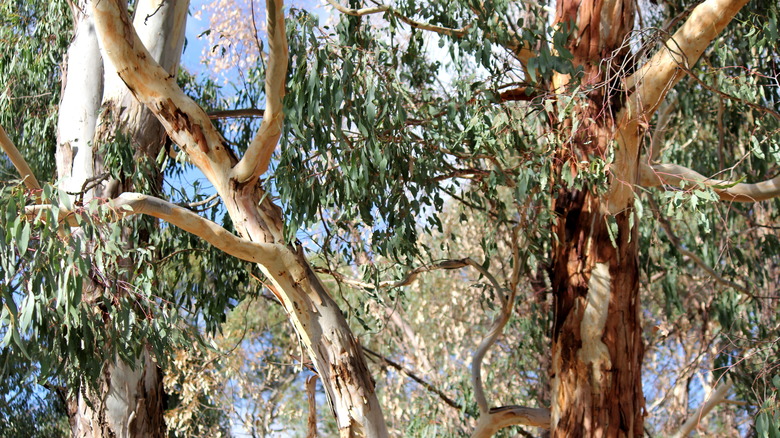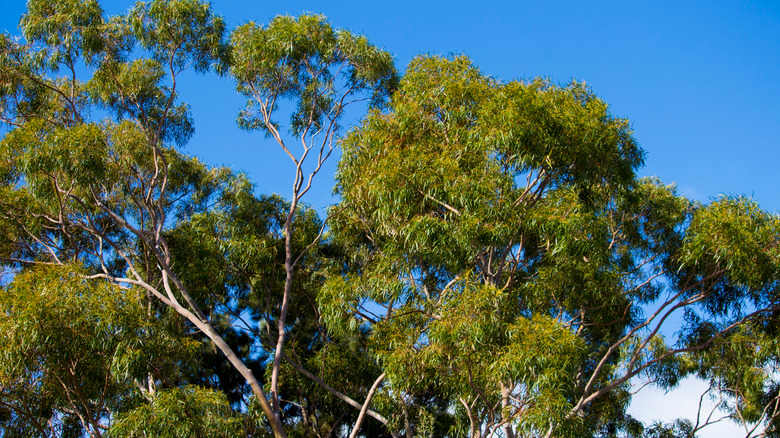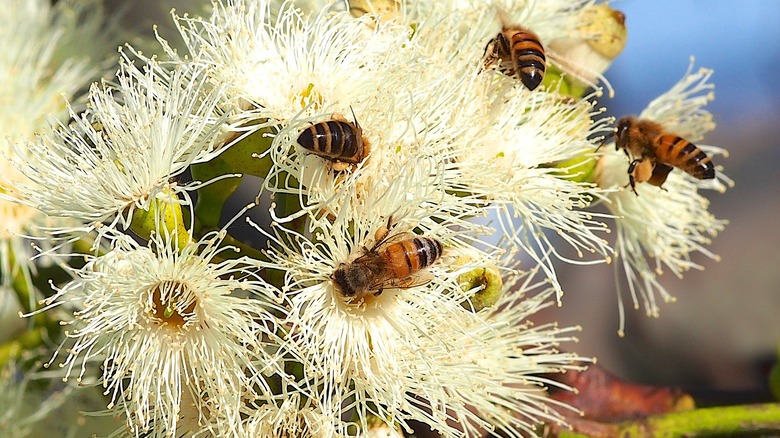15 Eucalyptus Trees That Will Add Drama To Your Yard
Australian natives found many uses for eucalyptus (eucalyptus sp.), known alternately as the gum tree. They understood eucalyptus as an all-purpose plant with healing properties and that its aromatic oil not only had healing properties as a mentholated topical but could also be made into a medicinal tea. The historians at Woodland Trust report that eventually, eucalyptus trees were used in everything from early warfare as spears and shields to bowls, canoes, and even musical instruments.
In their homeland, eucalyptus trees are closely identified with koalas, the small marsupials who spend most of their lives feasting on their bark and blue-green leaves far from the reach of predators. The U.S. experiences colder weather than most varieties of eucalyptus can endure, so the trees do best in Southern yards from Florida to Texas. They were also introduced around the time of the Gold Rush to Southern California. Some heartier varieties tolerate cold climates, though, and those can be found as far north as Washington state and the Carolinas.
Eucalyptus trees can quickly create a bold visual compliment since they grow as much as 10 feet a year. However, they are also considered highly flammable — so much so that legends tell of them bursting into flame on their own. While there are species (more than 700 of them) and subspecies galore when it comes to eucalyptus, botanists have simplified matters by identifying two main categories, according to PlantSnap: trees and mallees. Mallees are the bushy shorter variety, easily identified because they have more than one stem visible above ground.
Silver dollar gum eucalyptus tree
The silver dollar gum tree (Eucalyptus Polyanthemos) is distinguished by its silvery-white leaves — a clear resemblance to silver dollars. These trees are so entrenched in California that they're regarded in some areas as invasive. Their leaf canopies make them a great spot to cool off in the shade.
Silver dollars can reach heights of 75 feet. They're ideal for zones 9 and 10 and are tolerant of drought once their roots have taken hold. They prefer full sun but tolerate shade, and they'll grow in nearly any type of soil but prefer life in dry-to-wet soils.
Southern blue gum eucalyptus tree
The southern blue gum tree (eucalyptus globulus) is among the world's tallest. It's also the most commonly found in California because of its rapid growth, lush canopy, elegant appearance, and ability to withstand drought.
Cultivated, these trees top out around 150 feet, so they're not for every yard. They're best grown in zones 9 to 11 and like more acidic soils (like clay) and even nutrient-deficient soils. They appreciate full sun, can last through partial shade, but won't thrive in full shade. They tolerate wet conditions and can retain water exceptionally under drought-like conditions.
Blue-leaved mallee eucalyptus tree
You'll see the blue-leaved mallee (eucalyptus polybractea) in abundance Down Under, its ancestral home. It grows without much encouragement to the point that it is Australia's most grown tree. They're equipped with lignotubers so that in the event of a fire, they quickly resume life. They're also a main source of eucalyptol — up to 90% by weight.
Blue-leaved mallees grow to about 30 feet, excel in zones from 8 to 11, and thrive under a variety of moisture conditions and soil types. They like full sun exposure.
Snow gum eucalyptus tree
The snow gum (eucalyptus pauciflora) eucalyptus tree is one of those trees from a fairy tale. Their gnarled twists, smaller size, and adaptability to colder climates make them a conversation starter.
These are of the mallee variety and generally grow no more than 50 feet tall. They grow with the least help in zones 6 to 9 and prefer soil that's on the moist side, but they can hold out through shorter droughts. Snow gums prefer soils that are more nutrient-rich, although they can survive in a variety of spots. These trees like partly sunny to full sun spots.
Red gum eucalyptus tree
The red gum (eucalyptus camaldulensis) is something of a catch-all for an assortment of species that defies easy categorization. Californians once planted them en masse along their coast. They grow rapidly but aren't particularly sturdy, so keep an eye to the sky. There's also disagreement about whether red gums are a mallee because they originate from a single trunk but boast offshoots thick as the main trunk.
This tree can reach a height of 50 feet, tolerates a variety of soils, and does best in zones 9 and 10 — especially on wet riverbanks under complete sun.
Spinning gum eucalyptus tree
The spinning gum (eucalyptus perriniana) demonstrates how truly adaptable eucalyptus trees are. This one will work in your yard if you see months of snow on the ground every year. There's a relative that's been domesticated to live in warmer spots — although it will still withstand a winter chill.
This is a mallee eucalyptus and will reach estimated heights of 30 feet. It grows comfortably in zones 8 to 10, favors acidic soils that are dry to barely moist, and responds best to full sun exposure.
Candlebark eucalyptus tree
The candlebark eucalyptus (eucalyptus rubida) is an all-purpose single-trunk tree that provides such a lush canopy that it immediately conjures images of summer afternoons and hammocks. It can hold out through deep hard frosts unlike many of its relatives, and once it's begun to shed bark, there's a new colorful one below.
Candlebarks will grow anywhere from 30 to 100 feet. They do best in zones 7 to 10 and require attentive watering to settle in. Once established, they're a hearty species and resistant to dry spells. They like nutrient-rich soil that's well-drained and prefer full sunshine.
Rainbow gum eucalyptus tree
This rainbow gum tree (eucalyptus deglupta) isn't painted; that's its natural state. Also distinguished as the only one of 700 eucalyptus species not indigenous to Australia. It declines to thrive away from wet, warm spots like Hawaii and Florida, and it's also one of the tallest trees of the species.
Rainbow gum trees can grow to nearly 200 feet tall and require the tropical climates of zones 10 and 11. As a rainforest tree, it requires more water but fewer nutrients in its soil. It loves full sun.
Omeo gum eucalyptus tree
The omeo gum or Big O (eucalyptus neglecta) is yet another eucalyptus tree that doesn't mind chilling.' It's among the species smallest and most cold-tolerant of the mallee variety, and you'll find its deep hues of gray, blue, and green leaves in many a floral arrangement. It's also fairly compact for eucalyptus, seldom reaching heights greater than 20 feet.
This tree is best in zones 6b to 10. Its moisture needs are modest once it's gotten its roots in place. It will be happy in dry soil or considerably wetter and prefers partial to full sunlight.
Cadaga eucalyptus tree
The cadaga eucalyptus tree (eucalyptus torelliana) conforms to many of the expectations people have of eucalyptus. It grows quickly to heights around 40 feet (perfect for that backyard atmosphere) and blooms in dazzling white flowers. You'll see these trees keeping homeowners cool throughout Southern Florida. Fair warning: in some of the places it likes to grow, it's considered invasive.
This tree likes it hot and humid and grows best in zones 10 and 11. Although it can do well under slightly alkaline conditions, it prefers moderately acidic soils and partial shade to full sun.
Cider gum eucalyptus tree
The cider gum (eucalyptus gunnii), if left unattended, will soar into the sky. Yet it can also be kept at hedge height if you can keep up with its fast growth. It is drought-tolerant and produces beautiful off-white flowers.
This tree manufactures a tappable sweet sap not dissimilar to syrup drained from the maple tree. Legend has it that indigenous Australians also ferment the sap to make alcoholic refreshments. It does best in zones 8 to 10 with loamy to sandy soil, likes occasional water, and requires part sun to full sunshine.
Dwarf blue gum tree
The dwarf blue gum eucalyptus (globulus 'compacta') reaches maturity quickly and tops out at 30 feet tall, although it can be pruned to a third of that and thrive. They reward you in winter with off-white flowers but also leave behind dozens of blue-hued seed pods every summer.
This tree grows best from zones 9 to 11 and is frost-tolerant. It can also be kept low enough to the ground and trimmed into a hedge. Once established, it has modest needs for water. It will do well enough in partial shade but craves full sun.
Mountain gum eucalyptus tree
The mountain gum (eucalyptus dalrympleana) is an evergreen with pure white bark, a broad canopy, and exotic branch configurations. The tree blooms in orange, yellow, and white umbels late in summer. They can grow well past 50 feet in height. Owners claim there's so much water rushing through this tree that you can hear it gushing upwards if you listen. Its oil is considered an anti-viral.
This tree grows best in zones from 8 to 10. It's tolerant of various soil types, prefers landscapes on the dry side, and enjoys as much sun as possible.
Lemon scented gum tree
The lemon scented gum (eucalyptus citriodora) can grow well past 50 feet and is known for its two kinds of leaves — the more grainy juvenile leaves that resemble sandpaper and the verdant glossy leaves of its maturity. The real fun fact is that both varieties produce citronella, which is not only a natural mosquito repellent but an ingredient used in perfumes.
This tree prefers the warmth of zones 9 and 10. It can adapt to mildly acidic soils but prefers a very alkaline well-draining environment, has modest water needs after becoming established, and likes partial or full sun.
Sugar gum eucalyptus tree
The sugar gum eucalyptus tree (eucalyptus cladocalyx) is yet another Australian transplant believed brought to California for its ornamental beauty in creating dramatic landscapes as well as fuel and wood. Over the decades, they've adapted so well that they're considered invasive now, and can grow to more than 65 feet high. They produce a strong metholated aroma and tolerant of drought.
This evergreen likes loamy clay or sand, prefers semi-arid climate, and does best in zones 8 to 10. It also prefers partial sun to full sunlight.
